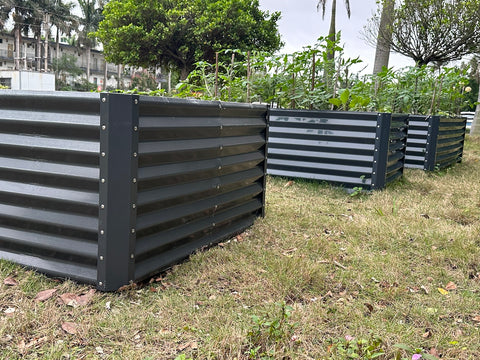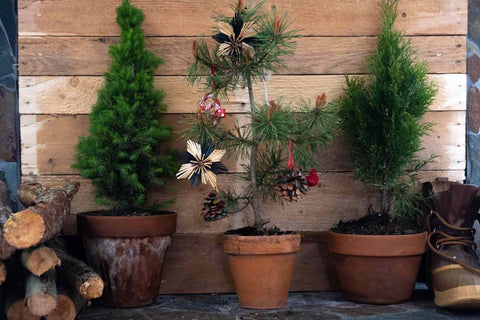As winter's icy fingers tighten their grip, gardeners often find themselves facing the aftermath of frost damage on their beloved plants. December may seem like an unlikely time for rehabilitation, but it's a crucial juncture for nurturing your garden back to health. In this comprehensive blog, we'll delve into the intricacies of frost damage recovery, exploring the types of damage, the plants most susceptible, and actionable steps you can take in December to ensure a vibrant and resilient garden in the coming spring.The following content also has some reference value for raised garden beds.
Understanding Frost Damage
- Types of Frost Damage:
Frost damage manifests in various forms, from superficial browning of leaves (frost burn) to more severe tissue damage and even death of plant cells. Vulnerable plants experience disruptions in their cellular structure when ice crystals form within plant tissues.
Gardening Tip: Recognize the signs of frost damage, including wilted or blackened foliage, to identify affected plants.
- Plants Most Susceptible:
Certain plants are more prone to frost damage than others. Tender perennials, tropical plants, and young seedlings are particularly vulnerable. Additionally, plants with high water content, like succulents, can suffer from cell rupture when exposed to freezing temperatures.
Gardening Tip: Know the susceptibility of your plants to frost and take preventive measures accordingly.
Rehabilitating Plants Affected by Frost

- Assessing the Extent of Damage:
Begin the recovery process by assessing the extent of frost damage on your plants. Gently inspect leaves, stems, and buds for signs of discoloration, wilting, or damage.
Gardening Tip: If in doubt, wait until late winter or early spring to trim back damaged growth. Some plants may still recover, and premature pruning may cause further stress.
- Pruning Damaged Portions:
Trim back any visibly damaged or blackened portions of the plant. Cut at a 45-degree angle just above a healthy bud or lateral branch. This encourages new growth and prevents the spread of disease.
Gardening Tip: Use sharp, clean pruning tools to minimize the risk of additional stress or infection.
- Applying Mulch for Insulation:
Apply a layer of organic mulch around the base of plants to insulate the soil and roots. Mulch helps regulate soil temperature, preventing rapid freezing and thawing that can cause further stress to recovering plants.
Gardening Tip: Keep mulch a few inches away from the plant's base to prevent moisture-related issues.
- Providing Adequate Watering:
Watering is crucial for frost-damaged plants, especially if the soil is dry. Hydrate the plants thoroughly, allowing the roots to absorb moisture and support recovery.
Gardening Tip: Watering should be done in the morning to allow excess moisture to evaporate, reducing the risk of fungal diseases.
- Using Frost Cloth or Blankets:
If frost is forecasted, protect vulnerable plants by covering them with frost cloth, old blankets, or burlap. This provides a barrier against freezing temperatures and minimizes frost damage.
Gardening Tip: Secure the coverings loosely to allow air circulation while providing insulation.
Winterizing Plants for Future Protection
- Choosing Frost-Resistant Plants:
When planning your garden, select plants that are more resilient to frost. Native species and those adapted to your region's climate are often better equipped to withstand winter challenges.

- Planting in Sheltered Areas:
Position vulnerable plants in sheltered areas, such as near the south side of buildings or under the canopy of larger trees. These locations offer natural protection from harsh winter winds.
- Applying Protective Sprays:
Anti-transpirant sprays or horticultural oils can be applied to evergreen foliage to reduce moisture loss and minimize frost damage. Follow product instructions carefully.
- Providing Windbreaks:
Install temporary windbreaks, such as burlap screens, around vulnerable plants to shield them from drying winter winds. This is especially beneficial for newly planted or sensitive specimens.
Ensuring Long-Term Plant Health
- Strengthening Plant Immunity:
Regularly apply organic fertilizers and amend soil with compost to enhance overall plant health. Strong, well-nourished plants are more resilient to environmental stresses, including frost.
- Monitoring Weather Conditions:
Stay informed about local weather forecasts, especially during frost-prone months. Be prepared to take protective measures when frost is predicted.
- Creating Microclimates:
Use structures like cold frames or row covers to create microclimates within your garden. These can provide additional protection for vulnerable plants during cold spells.

Conclusion: From Frost's Grasp to Garden Renewal
While the frosty fingers of winter may leave their mark on your garden, December offers a window of opportunity for recovery and renewal. With strategic interventions like pruning, protective coverings, and thoughtful plant care, you can turn the tide and set the stage for a resilient garden in the coming spring. As you navigate the challenges of frost damage recovery, remember that nature has an innate ability to rebound, and with your thoughtful assistance, your garden will emerge stronger and more beautiful than ever. May your December garden become a testament to the power of care and resilience in the face of winter's chill.









